Single pull macgregor type hatch cover.pdf - Cochin University of ...
Single pull macgregor type hatch cover.pdf - Cochin University of ...
Single pull macgregor type hatch cover.pdf - Cochin University of ...
Create successful ePaper yourself
Turn your PDF publications into a flip-book with our unique Google optimized e-Paper software.
must be guarded against. As these steels have low corrosion resistances, special<br />
coating, e.g. epoxies, are <strong>of</strong>ten used on the underside <strong>of</strong> <strong>hatch</strong> <strong>cover</strong>s where sweating<br />
can cause accelerated corrosion. Other materials such as higher tensile steel and<br />
aluminium are acceptable to the Classification Societies.<br />
3.4.1 Higher Tensile Steel (HTS)<br />
If the stress level within a structure were the only factor governing its scantlings, the<br />
use <strong>of</strong> higher tensile steel instead <strong>of</strong> mild steel would result in weight savings <strong>of</strong> up to<br />
15 percent. However stress is not the only governing factor. Deflection, minimum<br />
thickness, ease <strong>of</strong> construction, initial and maintenance costs must all be taken into<br />
account. Higher tensile steel (HTS) can sometimes be used for the beams <strong>of</strong> <strong>hatch</strong><br />
<strong>cover</strong>s, with their top plates made from mild steel. This reduces the weight <strong>of</strong> the<br />
<strong>cover</strong>s, without incurring the extra cost <strong>of</strong> using all HTS construction. Thus, HTS is<br />
sometimes used on <strong>hatch</strong> <strong>cover</strong>s where, by reducing the <strong>cover</strong> weight slightly, it may<br />
be possible to install less powerful operating mechanism. Construction entirely in<br />
HTS is sometimes used in pontoon <strong>cover</strong>s for container ships, to keep their weight<br />
below the maximum lifting capacity <strong>of</strong> container cranes.<br />
3.4.2 Aluminium<br />
Aluminium structures can be 55-60 percent lighter than equivalent mild steel<br />
structures. Most <strong>of</strong> the problems associated with higher tensile steel are not present<br />
with aluminium. Since it is not as strong as steel, thickness have to be increased,<br />
thereby alleviating problems associated with minimum regulatory deflection, buckling<br />
etc., unless the design is such that deflection is significant. Welding aluminium does<br />
however require special skills and equipment. Corrosion is less <strong>of</strong> a problem if the<br />
correct grade <strong>of</strong> material is used and if precaution are taken where steel and<br />
aluminium meet, e.g. at coamings. The spacing <strong>of</strong> stiffeners can be increased in an<br />
aluminium structures this has the added advantage that the number <strong>of</strong> stiffeners and<br />
hence the weight and cost <strong>of</strong> the structure can be further reduced. The major<br />
disadvantage <strong>of</strong> aluminium is that a suitable grade <strong>of</strong> material for access equipment<br />
costs approximately eight times as much per tonne as mild steel, with the overall<br />
effect <strong>of</strong> increasing the cost <strong>of</strong> the <strong>cover</strong> by upto three times.<br />
Aluminium <strong>cover</strong>s have been fitted to deep tanks because they are so much<br />
lighter. Since deep tank <strong>cover</strong>s are <strong>of</strong>ten made in one piece, aluminium <strong>cover</strong>s are<br />
36

















